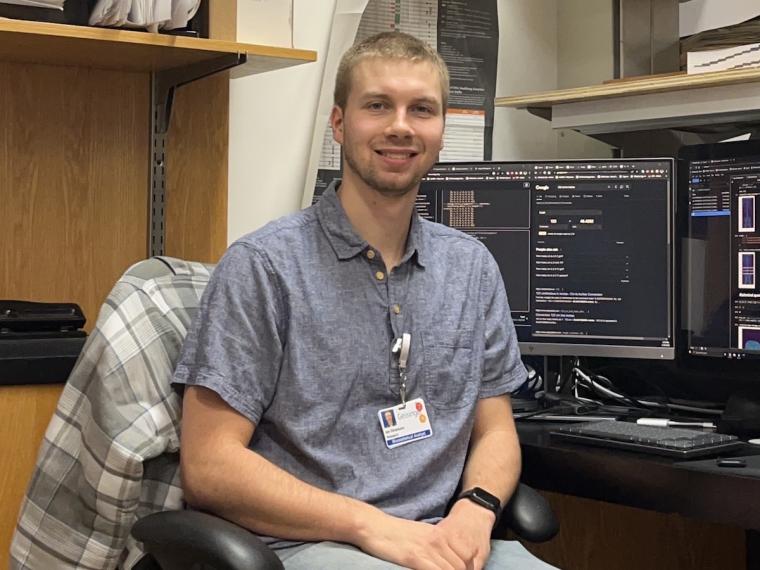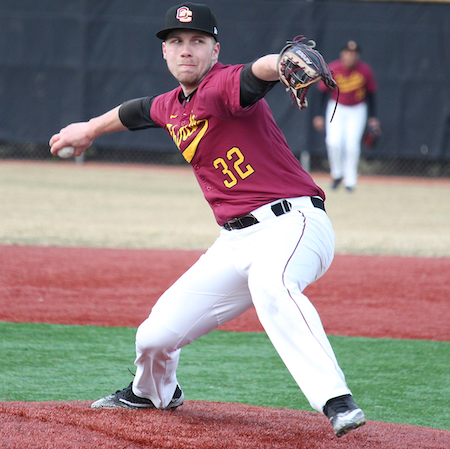How Biostatistical Analysts Are Born
Ian Dinsmore studied physics and math. Then an internship shed light on a new path.
March 1, 2023
Tyler Applegate

Photo credit: courtesy of Ian Dinsmore
Ian Dinsmore ’19 studied mathematics and physics at Oberlin while earning all-conference honors as a pitcher on the baseball team. By his senior year, he developed a passion for analytics that inspired him to pursue a master’s degree in business analytics from Case Western Reserve University’s Weatherhead School of Management in Cleveland. A Pennsylvania native, Dinsmore later returned home to the borough of Danville, where he works as a biostatistical analyst for Geisinger Health Systems—the same company where he completed a pivotal internship as a rising fourth-year student at Oberlin.
We caught up with Dinsmore recently after he spoke about his career path with current students in a program cooradinated by Oberlin’s Center for Engaged Liberal Arts…
What does a biostatistical analyst do?
My work is varied, but primarily I work with genetic data and electronic health record information to generate phenotypes, which are tested for associations with each other. This can include variants in a specific gene, or generally gene expression tied to changes in health. I also create novel data-analysis pipelines that are aimed at making available health information more effective in preventing disease—whether that’s through machine learning, data organization, or other forms of data management.
What do you love most about your work?
The most enjoyable part of my job is the creativity and freedom I have in finding solutions to questions from my lab. Working in research, we’re exploring ideas that have not been published and accepted by the scientific community at large, so being nimble in my work to adapt to the problem at hand is exciting. This can include writing code to automate a previously mundane, manual task, to developing a novel technique that can be published as a method for the broader community to use.
How did you know graduate school was the right step after Oberlin?
I knew going into my senior year I wanted to [work] in data analytics, and grad school was an option I knew I would be readily prepared for thanks to Oberlin. After my internship, I also knew that I had a lot more to learn in the field of analytics. This led me to looking into graduate programs, and Case Western was a great fit for me with the scholarship I received from the Ohio 5 Business Collaborative program. Case ended up being a great match, as it allowed me to take the STEM skills and knowledge I had received at Oberlin and apply them to the analytics field.
You were a double major and a varsity athlete during your time here. What was it like balancing everything?

It was definitely busy! There were times, in my junior and senior years especially, where I had to focus on school and finish homework or projects and miss some social events with my friends. But it rarely was completely overwhelming, and it really prepared me for my current position and work I will pursue in the future. It greatly developed my time-management skills, and looking back, I don't think I would have changed my path at all. I loved my time in both the mathematics and physics departments, and also found great joy representing Oberlin athletics.
What role did your Oberlin mentors play in shaping your career path?
My professors at Oberlin were critical in shaping my career path. The professors in the physics and math departments—really everywhere at Oberlin—were incredibly helpful, encouraging, and challenging. My senior year, I had quite a few discussions with my advisor, [physics professor] Jason Stalnaker, about my career path, and he was great at providing me with answers and insight to any questions I had. Without the education that my professors provided me, I would not have been nearly as successful at Case or in my current position.
What’s your fondest Oberlin memory?
My fondest memory is the time I spent together with my classmates and friends, whether that was doing homework or socializing together. I met so many great people at Oberlin that are still my best friends—it truly is a special place. We spent countless hours working together in the Science Center, or working in the libraries around campus. Just having those people I could depend on, by my side through it all, is what I miss most about being at Oberlin.
You may also like…
Josh Nolan Named Vice President, General Counsel, and Secretary at Oberlin
Distinguished attorney brings extensive experience in higher education law.
Learning by Teaching: Oberlin Students Share Global Music with Young Learners
College and Conservatory students in PACE 103 prepare local children for an immersive community concert at Oberlin.
Nuiko Wadden ’02 Joins Oberlin Conservatory Faculty as Assistant Professor of Harp
The versatile musician brings extensive opera, orchestral, and contemporary music experience to her role


